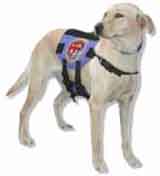Dog Behavior Problems and TrainingPsychotic Dog Behavior |
|
|
A psychosis is defined as a mental disturbance of such degree that there is personality disintegration and loss of contact with reality. The line between neurotic and psychotic behavior is not well defined, even by psychiatrists and psychologists. Two prevailing criteria can be added to the definition of a neurotic dog to describe, for this purpose, a psychotic behavior. These involve circumstances in which the dog's behavior is dangerous to himself or to the safety of others, and in which the dog appears to be unaware of the behavior during and/or very shortly thereafter his actions. If only the first criterion were to be applied to biting or self-mutilating dogs, then they would incorrectly be considered psychotic. In fact, many people believe that any biting dog should be labeled as a "psycho" and destroyed immediately, regardless of the circumstances. On the other hand, if the second element applies, and the dog is unaware of his behavior, it would seem reasonable to apply the psychotic label. The dog that appears to have withdrawn from reality or suffers episodes of withdrawal could be either psychotic or physically ill. If the behavior fits the basic neurotic model and is also in some way harmful to life or well-being, then the animal may be psychotic, if otherwise healthy. Dogs that are defined as psychotic have included the following symptoms: Dogs that suffer "avalanches" of rage for no clinical reasons and do not respond to external stimuli; manic-depressive animals that vacillate between depression and wild activity; and depressed dogs that fail to respond even to powerful stimuli, such as hunger, as when dogs starve to death in the presence of food. These cases have been seen in pet dogs as well as laboratory animals. The rage and manic-depressive states occur mainly in excitable types, whereas depression usually occurs in those with inhibitive tendencies. Some notable factors in the medical histories of apparently psychotic pet dogs are listed below. * Early distemper (before 3 months of age). * Serious parasitic infection (before 6 months of age). * Severe beatings. * Accidental injury, especially to the spine and/or head. * Accidental drug overdose. * Prolonged corticosteroid or other drug therapy. * Diabetes * Extreme psychic trauma. The underlying physical problems are rarely, if ever, investigated with the same dedication applied to humans with similar conditions. As a result, the dogs are generally destroyed, which solves the owner's immediate problem, but offers no progress toward understanding of the problem's causes.Back to the Dog Behavior Problems and Training page
| |
|
Related News About Dogs ' ); // get rid of newsfeed display by carp CarpConf('poweredby',''); CarpCacheShow('http://dogguidance.com/dogblog/?feed=rss2'); ?>
|
|
|
|
|
|
Copyright © 2006-2007 dogguidance.com |


